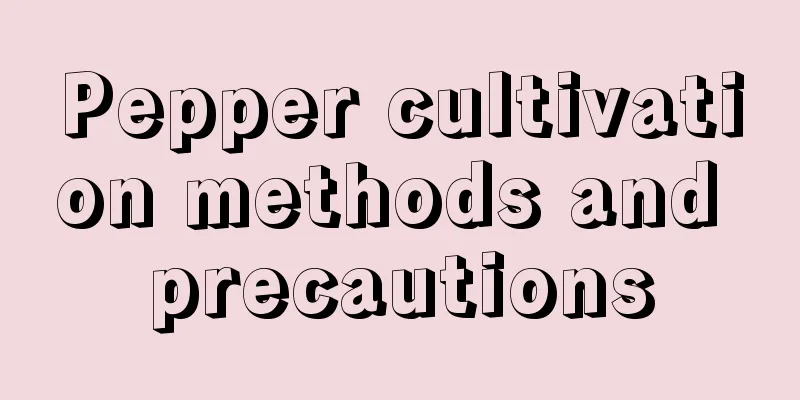Pepper cultivation methods and precautions

1. Maintenance methods1. Temperature: Different growth periods have different temperature conditions. For seeds sown in spring, the suitable temperature for development is between 15 and 30 degrees; during the growth period, the temperature should be controlled at around 20 degrees, because the growth state is best at this time. 2. Watering: It is not drought-tolerant or waterlogged. If the soil is in a dry state for a long time, the plant will die in less than three days. If the plant is in soil with stagnant water for a long time, the leaves will droop after a few hours, and in severe cases, it will die. Therefore, you must control the amount when watering it. Water it until the soil is completely moist but there is no water accumulation. Avoid watering on rainy days. The frequency of watering is once every three days. 3. Fertilization: Its growth consumes a lot of fertilizer. If the nutrition cannot keep up, the plant will appear weak. Use thin fertilizer each time you apply fertilizer, and water the plant once after fertilizing. One reason is to allow the fertilizer to melt into the soil for easy absorption by the plant; the other is to dilute the fertilizer and avoid fertilizer damage. The frequency of fertilization is once or twice a month. 4. Light: The demand for light is relatively high during the seedling stage, but there is no requirement for light. It is best to receive full-day sunlight. However, during the fruiting period, appropriate shade is needed. If the light is too strong, the fruit will easily rot. 2. Breeding techniques1. Reproduction: It can be propagated by sowing. After the climate stabilizes in spring, sow the seeds in holes, two to three seeds in each hole. After the seedlings emerge, pull out the seedlings that are not growing well. 2. Pruning: There is only one principle for pruning, which is to cut off the axillary buds growing from the leaf axils in time to avoid unnecessary consumption of nutrients. 3. Problem Diagnosis1. Pests: The plant is easily infected by borers, which will eat from the inside of the fruit, spread diseases, and affect the health of the plant. The plants need to be sprayed with carbendazim once every half a month to prevent them from being infected by pests. 2. Disease: The yellowing of the branches and leaves of the plant may be caused by lack of fertilizer. It is necessary to add nutrients to it. In addition to applying root fertilizer, you can also use foliar fertilizer. IV. Other issues1. Edible: edible. 2. Is it suitable for indoor cultivation: It can be grown indoors at home because it does not require high maintenance conditions and can be grown at home. |
<<: Almond cultivation methods and precautions
>>: Cultivation methods and precautions of nestweed
Recommend
A complete guide to the cultivation methods and precautions of Araucaria
1. Maintenance methods 1. Temperature: Araucaria ...
When do five-color plum, Jiangxi wax plum and bougainvillea bloom?
Five-color plum blossom season The flowering peri...
How to grow random grass
1. Maintenance methods 1. Temperature: 18 to 28 d...
8 recipes for making your own water-soluble fertilizer
Water-soluble fertilizer is a common fertilizer i...
How to grow crystal succulents well
Crystal succulent growing conditions Crystal succ...
The difference between short-spiked fishtail palm and fishtail palm
1. Difference of blades The lower leaves of the s...
Is it okay to put azalea in the living room?
1. Feng Shui In Guangdong, this kind of flower is...
Can Malan be potted?
Can Malan be potted? Amaranth can be grown in pot...
What fertilizer is best for iron tree
Fertilization time for iron tree The cycads gener...
What to do if gardenia does not produce new leaves
1. Control watering Watering of gardenia should b...
Best indoor plants to grow
Chlorophytum Speaking of plants that are easy to ...
Cultivation and breeding methods of fortune tree
The money tree is favored by many people because ...
When is the best time to repot the white palm
Time to repot white palm The growth rate of white...
How to fertilize Ficus ginseng
Time and method of fertilizing Ficus ginseng: In ...
How to grow wisteria on the balcony and what to pay attention to
1. Can it be grown on the balcony? Wisteria can b...









